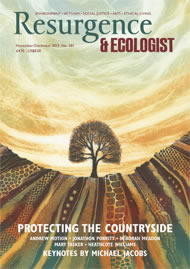Jay Griffiths begins her new book Kith with a riddle: why are so many children in Euro-American cultures unhappy? Why is it that children in many traditional cultures seem happier? She finds the answer in Nature.
Whereas Indigenous children all over the globe are rooted in their kith, their home patch or what the French identify as the terroir, the urbanised children of the West are alienated from what Griffiths calls their ‘childscape’. They are no longer in touch with their natural surroundings in the risk-averse, artificial and often virtual communities they inhabit.
These seemingly sweeping judgements are based on the author’s own seven years of experience of living in traditional communities, which she describes in her earlier book Wild, and the evidence she finds in the West of widespread childhood unhappiness. The 2007 UNICEF report on happiness and wellbeing, for instance, placed British children at the bottom of the international rankings, and in the six years since then levels of child and adolescent mental health disorders have markedly increased.
In this beautifully written and romantic view of natural childhood Griffiths argues that children in the West have become pawns of the neoliberal global economy – their role to make the transition from a childhood governed by “industrial Fordist routines in Gradgrind schools” to “an adulthood of passive consumerism”. They are “consumers in training” whose “brand loyalty” will last a lifetime. This is the aim of global corporations such as Edison and News Corp, both of which are increasingly coming to dominate the educational marketplace.
If we believe in the right of all children to have an experience of “nesting in Nature” that is free and unsupervised so that they may develop their imagination, their playfulness and their love of the natural world, then a radical revisioning of the way we rear them is needed. They need the space and freedom to play, to dream and to quest. Griffiths believes that such a “ludic revolution” has the power to reverse their growing alienation from Nature and would help them to reclaim their childscape.
Currently a flood of new books on Nature and wildness – by George Monbiot, Robert Macfarlane and Philip Hoare, amongst others – indicate a growing awareness of the need for wildness. Griffiths is one such writer. But she is not, as some reviewers have suggested, merely a sentimental romantic. It matters if children can no longer play in the fields, get lost in the ‘Wild Wood’, have conversations with forget-me-nots – all activities described lyrically by Griffiths and summed up as a state of grace.
Griffiths argues too that society needs the romance of childhood for its creativity. The ‘eternal’ child within us all responds to the ludic, anarchic fire of the dancer, the artist and the storyteller.
But at the same time as a new consciousness of ‘wild’ is emerging, the UK government has produced a new National Curriculum for five to fourteen-year-olds in England which prescribes a heavily loaded academic curriculum. Its purpose is to enable the UK “to compete in the global economic race”. So five-year-olds will be taught computer programming and debugging, as well as fractions. There is not much room for romance or play and it is significant that the art syllabus has dropped all reference to developing creativity and imagination.
Nevertheless, alternatives do exist worldwide, and Griffiths describes some of these. For example, Rabindranath Tagore’s school Santiniketan in India, the Forest Schools in Scandinavia, and the preschools in Reggio Emilia, Italy. It’s a pity that she doesn’t also mention Brockwood Park in Hampshire, or the Small School in North Devon (see page 28), both of which are inspired by Tagore’s philosophy.
In England, many teachers are aware of the need for children to be introduced to Nature at an early age and do make efforts to take them into the countryside, but they are up against a neoliberal government that has an instrumental view of children and of education. To read Kith is to renew faith in a philosophy of society and of education that is radically different. It is an oppositional act.







